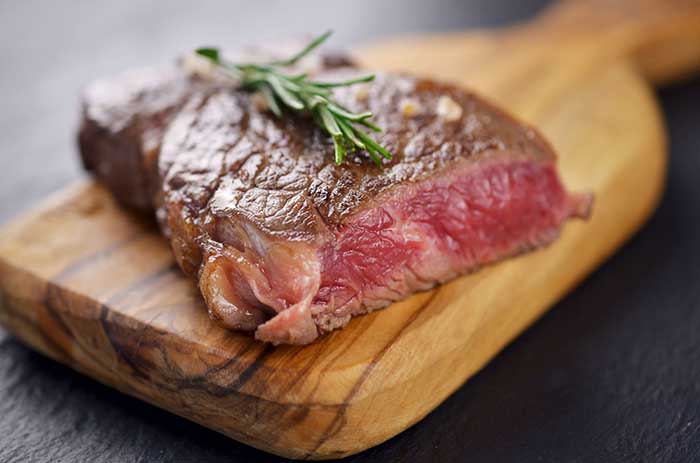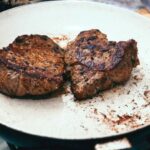The question ‘How would you like your steak?’ is almost as divisive amongst foodies as ‘How do you take your tea’? is among the British. Asking for Medium Well or Well is seen as sacrilegious to many a steak connoisseur who believes blue is the way to go for a truly delectable dining experience.

When it comes to steak, the first color that comes to mind is undoubtedly red, but have you ever heard of a blue steak?
The majority of people will usually order their steak medium, with the second most popular choice being medium-well. Only a very small percentage of people choose to have their steak blue rare, but it’s often suggested that it’s one of the best ways to eat a good steak to get the authentic flavor experience.

What is Blue Steak?
Blue steak is the name given to a steak that is lightly seared just long enough to cook the outside but leaves the inside red to the point of being almost raw. It’s also sometimes called an extra rare or blue rare steak.
Blue isn’t usually a color we see used to describe steak, but it’s fitting in this case as once the steak has been seared and first sliced into, it has a blue/purple hue due to a process known as oxygen depletion.
You may have noticed this same blue hue with vacuum-packaged beef that you can often find in the store. Vacuum sealing removes the oxygen from the packet to preserve the freshness of the meat. Because of this lack of oxygen, the myoglobin (the protein that gives meat its rich red color) stays this blue/purple color – as soon as the vacuum is released on the packet, the meat regains its typical color.
However, this blue color doesn’t last long; as soon as the meat is exposed to air, the proteins become oxygenated and turn to the usual red color we would expect.
Does a Blue Steak Taste Better?
When it comes to food, taste is subjective. What you love someone else might hate, but if we look at the science behind how cooking affects meats, you can get an idea of how heat, or rather the lack of heat, contributes to the taste and texture of a blue steak.
The taste and texture of cooked beef are all to do with how heat helps break down its proteins and fats. Since blue steak isn’t left on the heat long enough to raise the internal temperature fully, the proteins and fats don’t melt and diffuse into the surrounding tissue.
This makes for a steak that isn’t as juicy as one cooked to a more medium-rare level. People will often say that it has a spongey or chewy texture.
Is it Safe to Eat Blue Rare Steak?
When we talk about food hygiene around any kind of meat and it being safe, the first thing that most people’s minds jump to is raw or undercooked meat is bad and could be dangerous.
While this is the case for meats such as chicken and pork (undercooked pork can harbor parasites, and raw chicken can often be contaminated with salmonella), studies have shown that bacteria such as e.coli are mostly found on the outside of steaks so by searing the outside you are eliminating the risk.
Blue steaks that have been prepared properly by following food hygiene and safety guidelines are safe to eat. To avoid any issues, you need to make sure tongs used to transfer raw meat are always cleaned/sterilized and that the outside of the steak is completely seared before serving.
What Temperature to Cook Blue Steak to?
Your ideal target temperature to hit when cooking a blue steak should be between 115-120°F (46-48°C). If it’s below that, it is still considered raw and will not have been warmed through, any higher and it would be considered rare and not blue.
The best way to test the internal temperature is by using a digital probe thermometer. When the outside of your blue steak is seared, you need to insert the thermometer into the side of the steak until it reaches the center. Once the temperature reads at just around 5°F below the desired temp, remove it from the heat and allow it to rest. As with any cooked meat, the internal temperature will continue to rise for a short time after being removed from the heat.
Best Steak Cuts For Blue Rare
The types of steak cuts you should use for blue rare steaks veer away from the advice given for most other levels of steak doneness. As discussed above, the purpose of heat when cooking a steak is to help fats melt to produce an end product that is juicy and tender. Since a blue steak is cooked for such a short period of time, the fats don’t have a chance to render, so you want to go for a leaner cut with less fat. Here are some good cuts to consider:
- Tenderloin – The tenderloin cut of beef is taken from the loin of the cow, which is an area that doesn’t have any muscle, so there is not much fat on the cut. It’s one of the most tender cuts of beef meaning that it is perfect for blue rare steaks.
- Flat Iron – The flat iron steak is often regarded as the second most tender cut of beef after the tenderloin. It comes from the shoulder area of the cow, and although in the past it might have been deemed to be of lower quality (because of the amount of connective tissue that surrounds it), thanks to new butchering techniques and methods, it’s easy to remove and trim this tissue and produce a delicious piece of meat.
- Sirloin Tip – The sirloin tip comes from a part of the cow known as the round, which is on the rear leg. As it’s quite a muscular area, the cut can be a bit less tender than the tenderloin and flat iron, but its rich flavor makes up for that.
What Cuts To Avoid
For blue rare steak, you want meat that is already naturally tender. You should avoid cuts from any of the big muscle groups as muscles that are worked hard become tougher.
Since a cow is a grazing animal, areas such as the chuck, brisket and flank are muscles that are used to help support its weight and aren’t good choices of cuts for blue steak.
What is Pittsburgh Rare Steak?
A Pittsburgh rare steak, sometimes known as a black and blue steak, is the same as a blue rare steak but with a slightly different cooking process. Instead of being seared in a pan, the outside of a Pittsburgh steak is charred, giving it a well-done outside with black char marks while still being ‘blue’ on the inside.
Supposedly the name comes from the Pittsburgh steel mills back in the industrial era, where mill workers would cook steaks for their lunch on the sizzling hot blast furnaces. The surfaces they would place them on were so hot (over 2000°F) that it would quickly char the outside while leaving the inside nicely red, making it the perfect meal for a short lunch break.
How to Cook a Steak to Blue on a Grill
While searing a blue steak in a pan might be preferable, cooking a rare blue steak on the grill is also possible. All it takes is a bit of prep and the following simple steps.
- Make sure your steak is room temperature. If it’s been stored in the fridge, remove it and allow it to sit for 15-20 minutes to reach the ambient temperature.
- Your grill will need to be very hot to produce the sear we need to seal our steak. If you are using a gas grill, you will want the burners on full. If you are using a charcoal grill, you will need a load of charcoal with the vents open to provide sufficient airflow and subsequent heat.
- Once the grill is as hot as possible, place your steak on the rack over direct heat and leave the lid open.
- The steak should sit for no longer than a minute before you flip it to the other side; when you do this, place it on another part of the wire grill over direct heat (that way we know both sides have got the same maximum heat level.
- When it has sat on the other side for no longer than a minute, grab the steak with tongs and sear the sides. This is done easiest by using a slow rolling motion to ensure that every side of the steak has touched part of the grill long enough to sear it properly.
- Once it is fully seared, remove the steak from the grill and insert an instant-read digital thermometer – it should read between 115-120°F (46-48°C). The steak is ready to serve if the correct internal temp has been reached.










